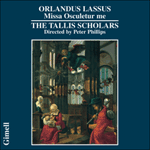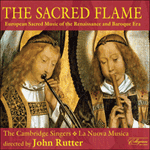
Welcome to Hyperion Records, a British classical label devoted to presenting high-quality recordings of music of all styles and from all periods from the twelfth century to the twenty-first.
Hyperion offers both CDs, and downloads in a number of formats. The site is also available in several languages.
Please use the dropdown buttons to set your preferred options, or use the checkbox to accept the defaults.

 PERFORMANCE
PERFORMANCE RECORDING
RECORDING
Allow the intermingling of the motet and madrigal styles in the composition of any musical works … in motets and concertos there is a special charm when several quite expressive and slow measures [Tempora] at the beginning are followed by several quick phrases [Clausulen], and then once again slow and stately passages alternate with faster ones. In this way [the composition] will not proceed in a constant monotonous fashion [in einem Tono und Sono fortgehe], but with an alternating slow and fast pace [Tact].
The request for ‘several quick phrases’ is fulfilled at the end of Lassus’ setting (and elsewhere): at the words ‘non confundar’ the text is consistently declaimed in minims and crotchets; in addition, syncopated displacements of the voices collide with each other. One would not necessarily expect to find a passage set in this manner in a motet, but rather in a madrigal, whereas the calm note values of the beginning have more of a motet-like character. The juxtaposition of such different stylistic layers within a piece is of course employed not only for the sake of variety, but also to interpret in an appropriate manner the text assembled from various passages in the Psalms. Hence, notably, the syncopations at ‘non confundar’ (‘let me not be confounded’) express the threat of being overwhelmed or confounded. The significance of the opening words ‘Timor et tremor’ (‘Fear and trembling’), with their long notes, is further reinforced by the abrupt changes of chord from ‘tremor’ onwards. Different again is the way Lassus handles the passage ‘Miserere mei, Domine’ (‘Have mercy on me, Lord’) in the first part of the setting: simple, repeated notes, which almost evoke the recitation of a litany, express a humble, prayerful attitude, but there is a sudden striking chord progression at ‘mei’, which introduces a personal, individual note. One should also single out the beginning of the second part of the motet, where the insistent ‘Exaudi, Deus’ (‘Hear, O God’) is followed by a ‘deprecationem meam’ (‘my prayer’) that slips tonally into, as it were, a different sphere, from G to E flat, once again expressing humility.
from notes by Bernhold Schmid © 2015
English: Charles Johnston
Permettre le mélange des styles du motet et du madrigal dans la composition de toute œuvre musicale … les motets et concertos présentent une esthétique particulière lorsque leurs premières mesures à la fois lentes et relativement expressives [Tempora] sont suivies de plusieurs phrases rapides [Clausulen], puis à nouveau de passages lents et majestueux en alternance avec des séquences plus vives. Ainsi [l’écriture] échappera à toute monotonie [in einem Tono und Sono fortgehe] en alternant un rythme lent et rapide [Tact].
La condition de «plusieurs phrases rapides» est remplie à la fin de la mise en musique de Lassus (et ailleurs): aux mots «non confundar», le texte est invariablement récité en minimes et semi-minimes; de surcroît, les mouvements syncopés des voix s’entremêlent. On ne s’attendrait pas nécessairement à découvrir un passage ainsi construit dans un motet, mais plutôt dans un madrigal, alors que la valeur des notes calmes du début se rapproche plus du caractère d’un motet. La juxtaposition de lignes stylistiques extrêmement différentes au sein d’une même pièce est non seulement employée pour produire une certaine variété mais aussi pour interpréter adéquatement le texte composé de différents passages des Psaumes. D’où notamment les syncopes à «non confundar» («ne permets pas que je sois confondu») pour exprimer la menace d’être submergé ou confondu. La signification des mots introductifs «Timor et tremor», avec leurs notes longues, est renforcée par les changements soudains d’accords à partir de «tremor». Encore différente est la façon dont Lassus a composé le passage «Miserere mei, Domine» dans la première partie de l’œuvre: des notes simples répétées, évoquant la récitation d’une litanie, expriment une attitude de prière, interrompue par une saisissante progression d’accords à «mei» introduisant une note personnelle. Il serait également intéressant de mettre en lumière le début de la seconde partie du motet, où «Exaudi, Deus» («Entends, Dieu») est suivi des termes «deprecationem meam» («ma prière») menant tel quel à une sphère tonale différente, de sol à mi bémol, exprimant, une fois encore, l’humilité.
extrait des notes rédigées par Bernhold Schmid © 2015
Français: Hypérion
… Moteten, dieweil sie vff die rechte Motetten Art / deren sich der Orlandus (quem in isto genere hac nostrâ memoriâ Primas tenere arbitror) gebrauchet …
So schreibt Michael Praetorius im dritten Band (S.9) seines Syntagma musicum (Wolfenbüttel 1619); Lasso ist seiner Ansicht nach also derjenige Musiker, der Motetten in der „richtigen“ Weise komponiert. Und der lateinische Teil des Zitats—zu deutsch: „den ich für den Primas [also den Ersten, den Fürsten] seit Menschengedenken in dieser Gattung halte“—besagt, Lasso sei der bedeutendste Motettenkomponist überhaupt. Warum? An anderer Stelle des Syntagma musicum (S.51) rühmt Praetorius Lassos Fähigkeiten im Umgang mit den vertonten Texten. Schließlich spricht er sich dafür aus, „daß man in compositione alicujus Cantionis [beim Komponieren jeglicher Art von Gesängen] zugleich Motettische vnd Madrigalische Art vntereinander vermischen solle.“ (Syntagma musicum III, S.80) Er fährt fort:
Sintemahl es den Motecten vnd Concerten eine besondere lieblich: vnnd anmütigkeit gibt vnnd conciliiret, wenn im anfang etliche viel Tempora gar pathetisch vnd langsamb gesetzet seyn / hernach etliche geschwinde Clausulen daruff folgen: Bald wiedervmb langsam vnd gravitetisch / bald abermahl geschwindere vmbwechselung mit einmischen / damit es nicht allezeit in einem Tono vnd Sono fortgehe / sondern solche vnd dergleichen verenderungen mit eim langsamen vnd geschwinden Tact.
Auch wenn an der zitierten Stelle Lasso nicht genannt wird, liest sich die Passage wie eine Kurzcharakteristik seines Komponierens, da er immer wieder gattungstypische Stilelemente vermischt und somit Gattungsgrenzen durchbricht.
Mit der 1564 erstgedruckten Motette Timor et tremor haben wir ein Stück vor uns, das Praetorius’ Ausführungen eindrucksvoll bestätigt. Breven, also lange, ganze Takte füllende Notenwerte, eröffnen das Stück; dies entspricht exakt Praetorius, der „im anfang etliche viel Tempora gar pathetisch vnd langsamb gesetzet“ haben will. Und (nicht nur) am Ende des Satzes wird die Forderung nach „etliche[n] geschwinde[n] Clausulen“ erfüllt: Bei der Stelle „non confundar“ wird der Text durchgehend auf halben und Viertelnoten vorgetragen; dazu kommen synkopische Verschiebungen der Stimmen gegeneinander. Eine so komponierte Stelle würde man nicht unbedingt in einer Motette vermuten, sondern in einem Madrigal, während die ruhigen Notenwerte des Beginns eher motettischen Charakter haben. Das Gegenüberstellen so unterschiedlicher stilistischer Schichten innerhalb eines Stücks geschieht natürlich nicht nur der Abwechslung halber, sondern um den aus diversen Psalmstellen zusammengebauten Text (Psalm 54: 6; 56: 2; 60: 2 sowie 30: 4 und 18) in angemessener Weise auszudeuten. So drücken insbesondere die Synkopen bei „non confundar“ („lass mich nicht umsonst flehen“) die drohende Verwirrung aus. Das Gewicht der einleitenden Worte „Timor et tremor“ („Furcht und Zittern“) mit seinen langen Noten wird noch verstärkt durch die abrupten Klangwechsel ab „tremor“. Wiederum anders begegnet Lasso der Textstelle „Miserere mei, Domine“ („Erbarme dich meiner, Herr“) im ersten Teil des Satzes: Schlichte, wiederholte Klänge, die fast an den Vortrag einer Litanei denken lassen, drücken demütige Gebetshaltung aus, auffallend aber der scharfe Klangwechsel bei „mei“, der persönlich Individuelles einbringt. Hingewiesen sei noch auf den Beginn des zweiten Teils der Motette, wo dem eindringlichen „Exaudi, Deus“ („Erhöre, Gott“) das tonartlich von G gleichsam in eine andere Sphäre nach Es verrutschte und damit wiederum Demut ausdrückende „deprecationem meam“ („meine Bitte“) folgt.
aus dem Begleittext von Bernhold Schmid © 2015
 Lassus: Missa Osculetur me Lassus: Missa Osculetur meThe first recording of the magnificent motet and Mass Osculetur me by Lassus, both scored for double choir, together with a selection of his sacred motets.» More |
 The Sacred Flame The Sacred FlameA treasure-trove of outstanding motets, including works by Bach, Buxtehude, Gabrieli, Gesualdo, Monteverdi, Palestrina, Schütz and Sweelinck. All performed by the Cambridge Singers at their sensuous and virtuosic best.» More |

